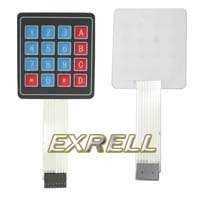I do not have any problem but I found a solution to a problem I have had - hopefully someone else will find it useful.
I have bought some 4x4 16 key matrix membrane keypads - see image. They are very cheap and very useful – but interface to them require normally 4+4=8 ports.
I can use normal charlieplexing and then only use 4 ports but then I cannot use the diagonal keys!

I tried use the analog method connecting seven resistor coupled as a voltage divider and use only one AD ports – it works but I’m not sure have stable it is.
After some thinking and investigating I found out that it was possible to extend the charlieplexing by adding an extra diode for every column. Using 8 diodes instead of 4. See the sketch. The tricks is to pull two lines low at key press instead of one line - except for the diagonal where only one line is pulled low.
If you use normal charlieplexing and have n ports you can use these n ports to manage (nn)-n keys using n diodes. At my method, the extended charlieplexing, you can with n ports manage nn keys but it require additional n diodes total of 2*n diodes.
Sample code to test the extended charlieplexing:
#define RK_0 B10000100
#define RK_1 B00011000
#define RK_2 B00011100
#define RK_3 B00010110
#define RK_4 B00101001
#define RK_5 B00101100
#define RK_6 B00100100
#define RK_7 B01001001
#define RK_8 B01001000
#define RK_9 B01000010
#define RK_NUM B10000110
#define RK_STAR B10000001
#define RK_A B00010010
#define RK_B B00100001
#define RK_C B01000011
#define RK_D B10000011
const int pinKM[] = {4,5,6,7}; // four pins to Keyboard Matrix
void setup(void)
{
Serial.begin(9600);
}
void loop(void) {
char c = ReadKey();
Serial.println(c);
}
// ------------------- ReadKey -------------------
// wait for a key to be pressed
char ReadKey(void) {
char c;
byte r;
unsigned long ti=millis()+2000; // simple autorepeat
while (0!=ReadKeyboardRaw() && ti>millis()); // wait for previeus key to be unpressed..
do {
while (0==(r=ReadKeyboardRaw()));
delay(10);
}
while( r!=ReadKeyboardRaw() );
switch(r) {
case RK_0: c = '0'; break;
case RK_1: c = '1'; break;
case RK_2: c = '2'; break;
case RK_3: c = '3'; break;
case RK_4: c = '4'; break;
case RK_5: c = '5'; break;
case RK_6: c = '6'; break;
case RK_7: c = '7'; break;
case RK_8: c = '8'; break;
case RK_9: c = '9'; break;
case RK_NUM: c = '#'; break;
case RK_STAR:c = '*'; break;
case RK_A: c = 'A'; break;
case RK_B: c = 'B'; break;
case RK_C: c = 'C'; break;
case RK_D: c = 'D'; break;
default: c = '?';
}
return c;
}
// ------------------- ReadKeyboardRaw -------------------
byte ReadKeyboardRaw(void) {
byte rawkey=0;
for(byte i=0;i<4;i++) {
// setup ports..
for(byte j=0;j<4;j++) {
if (i==j) { // output '0'
pinMode(pinKM[j], OUTPUT);
digitalWrite( pinKM[j], LOW);
}
else { // input
pinMode(pinKM[j], INPUT);
digitalWrite( pinKM[j], HIGH);
}
}
delay(1);
// read ports..
for(byte j=0;j<4;j++) {
if (i!=j) {
if (LOW==digitalRead(pinKM[j])) {
bitSet(rawkey, j);
}
}
}
if (rawkey!=0x0) { // key pressed, return key
bitSet(rawkey, i+4);
break; //return rawkey;
}
}
return rawkey;
}
